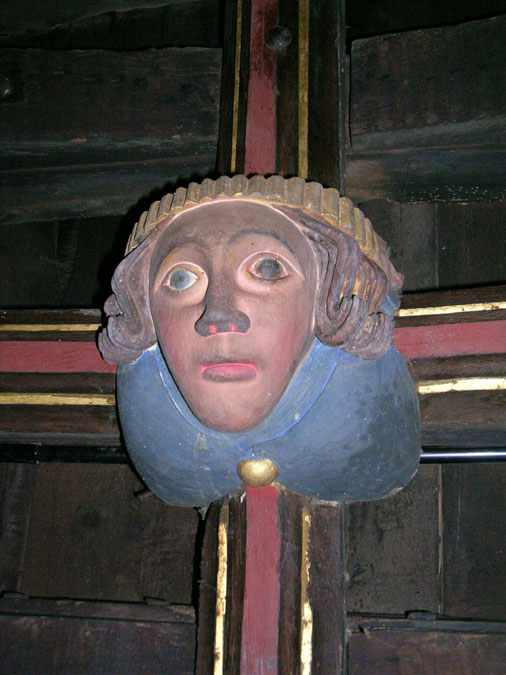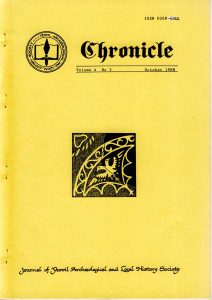This article came from the Chronicle published November 1988. Pages 76-78
SCHOOLDAYS IN YEOVIL IN THE 1890’s.
Author: Leslie Brooke
The following extracts are from recollections of A.J.B.Milborne, written in 1950, when he was living in Canada. He was born at 12 Princes Street, Yeovil, on 23rd August 1888, his father ‘at the time a prosperous tailor’, and his mother ‘a Londoner who had formerly been a nurse at the Salisbury Infirmary’.
The Milbornes’ ancestors had traditionally always been tailors and drapers, the most noteworthy having been Sir John Milborne, a draper in the reign of Henry the Eighth, and Lord Mayor of London in 1522, A.J.B’s grandfather, a tailor and draper in Princes Street, was born in Yeovil about 1815. He died as the result of a railway accident at Bath, when the Widcombe Bridge collapsed as the result of extra heavy traffic during the celebrations of the centenary of the Bath and West of England Society, in June 1877.
A.J.B.Milborne’s education may be said to have started when he had a governess, named Manley, from Evershot, who was engaged ‘to drum into the head of my sister and into mine, the rudiments of education’. His recollections continue: ‘The earliest memory of my schooldays was taking lessons in reading from Mrs.Monk, the wife of Henry Monk. At that time the Yeovil Grammar School, of which Henry Monk was Headmaster, was in a fairly prosperous condition. There were certainly no less than fifty or sixty boys in attendance.
‘The rival school Aldrich’s (Aldridge’s), ‘where my father was educated, was then on the downgrade, to be resurrected with the coming of a new Master named Budd (the name was actually Rudd) with more modern ideas. Like so many schools under the English system of private education, these schools last but the lifetime of the proprietor, and by the time I left school, the old school had dropped to but a dozen pupils, the old building on Hendford had been closed and the school was housed in an old building behind St.John’s Church, which from its construction, I believe had formed part of the original ecclesiastical foundation of that parish’. (This was The Chantry, formerly in St.John’s churchyard, adjacent to the tower, and which had once been the chantry chapel of the Blessed Virgin Mary without the Church -LEJB). ‘We used to sit on the high wall to eat currant rolls (2d) purchased at Banfield’s in the Borough.
‘I do not recall how old I was when I first went to Monk’s School, but I remember the gravelled yard, because it was hard on the knees if one should fall in playing the usual games, rounders, ‘iacky’ etc. Then there was the open space under the school building where we played when the weather was wet, at the end of which was the “Bog”, an awful six-holer, which stank to high heaven. The School was held in one large room, heated by a wood stove on which pans of water were evaporating. Old Monk nearly always had a drop on the end of his nose, and I imagine we all did, too, though we boys probably used unpolite methods of removing them.
‘Mr.Monk’s daughter, and his son-in-law were the staff, and I think we all got a fair education there, though the curriculum did not contain so many subjects as are taught in primary school today. I still have my old Euclid – the pons asinorum is still a deep mystery to me. We took French and Latin, and I can still recall snatches of Caesar and Remus and Romulus. Mr.Monk was a grand character, beloved by all his pupils (at least in later life) and I have always felt a pang of regret that I once hit him in the face with an overripe tomato that was intended for one of my fellow pupils. In those days the cane was an important part of the equipment of a schoolmaster, and old Monk used it with vigour. I got it once or twice, and I think it is a pity that is use has disappeared. It instilled respect into the boys for their elders and betters which is non-existent today.
‘I had not been long at school when my father got into the first of his business difficulties, and we had to leave Princes Street and move to No.32 Kingston … My sister had by this time been enrolled as a pupil at Mrs. Nosworthy’s establishment for the education of young ladies, known as Girtin School, and as I was taking lessons from old Nosworthy, a cantankerous fellow, I also was compelled, much against my will, to go to this Girls’ School twice a week to practise under the tutorship of a soured and vinegary spinster named Whittle, who made frequent use of a long pencil upon my knuckles. They had curious ways of teaching music in those days, and I nursed a consuming hatred for these two teachers of music.
‘It was Nosworthy who insisted on the entering into the pages of a little book the hours of practice I spent at the piano, which led me into certain infringements of the moral code… I remember nothing that these two taught me, though I can play pieces of music taught to me by Mr. Bastick in my early teens. This Miss Whittle was not a relative of a Mr.Whittle who, on Saturday nights, used to dispense delightful and mouth-watering confections of his own manufacture in the market-place under the glare of naptha flares, and to whom I paid willing tribute from my penny or tuppenny weekly pocket money… In 1897 we moved to less expensive quarters at No.4 Peter Street. Here my father was close to the Church! (Holy Trinity where he played the organ). He also obtained pupils for the piano and organ…
‘In 1900 my father was again in financial difficulties… and we moved to an old-fashioned house on Market Street. … The change in the family’s fortunes when we moved to Market Street affected me, because mother found she could no longer pay my school fees. I was then a little over 13 years of age. So I left Monk’s School and obtained a job as a proof-reader on the Western Gazette. Mr.Monk was sorry to see me leave school at such an early age, and very kindly undertook to continue my instruction in the evenings, and this arrangement continued for about a year. Then I enrolled as a pupil of the Evening Continuation School at Reckleford, which was under the direction of a man named Perry, and the only thing I can recall about this was that he had smelly feet.
‘Tiring of the piano, I was provided with a violin, and took lessons from a Mr. Ricketts … Being “musically” inclined, however, I, of my own volition, bought a banjo, receiving lessons from an old man named Harrison who lived in Huish, one of our poorer neighbourhoods. The old boy gave me a good grounding and eventually I became a fairly accomplished player to the extent that I was capable of performing in public. I also picked up a few shillings myself in instructing others in the art…
‘My entry into the newspaper world necessitated a knowledge of shorthand and I took lessons from a Mr.V.O.Dover, who was sound instructor in Pitman’s. My knowledge of shorthand was not acquired easily, but my fundamental instruction was sound, and in time I became something of an expert, and was an Evercirculator group member, with membership all over the world, and ready to meet in the public prints any attack upon Pitman’s by the devotees of the other so-called shorthand systems’.
This ends Mr. Milborne’s recollections of his education in Yeovil, though there are other interesting details which may form the subject of notes in subsequent issues. These extracts are from family records loaned by Mr. and Mrs.P.Sampson, of Minehead, who have kindly granted permission for their use in ‘Chronicle’. Mrs.Sampson, who is 85, is a surviving member of the Milborne family of Frome.

